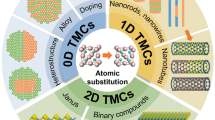Abstract
A novel approach for fabricating one, two, and three-dimensional hybrid ZnO and Cu2O nanostructures has been developed. We have controlled the thickness of hybrid ZnO nanosheets to reach nanoscale at room temperature. The ability of engineering hybrid ZnO nanowires in few minutes is demonstrated. Moreover, supposed mechanism has been suggested and supported by the in situ SEM analysis for a series of picked samples during the reaction. The morphology transition of Cu2O nanoparticles to hierarchical nanowires and nano-flowers is highlighted as experimental evidences for Abdelmohsen theory for morphology transition engineering (ATMTE). In addition, the ability of multi-walled carbon nanotubes (MWCNTs) to act as a structural directing material for engineering nanowires is introduced. A hypothesis for engineering of micro and nanostructures (HEMNS) that may be applied for nearly all solid materials is demonstrated. Finally, the possibility of engineering Zn-oxidene and thin films are introduced.

Highlights
-
A novel approach for fabricating one, two, and three-dimension hybrid ZnO and Cu2O nanostructures has been developed.
-
We have controlled the thickness of hybrid ZnO nanosheets to reach nanoscale at room temperature.
-
The ability for engineering hybrid ZnO nanowires in few minutes is demonstrated.























Similar content being viewed by others
References
Park MS, Kang YM, Wang GX, Dou SX, Liu HK (2008) The effect of morphological modification on the electrochemical properties of SnO2 nanomaterials Adv Funct Mater 18:455–461
Tanaa, Zhang M, Li J, Li H, Li Y, Shen W (2009) Morphology-dependent redox and catalytic properties of CeO2 nanostructures: nanowires, nanorods and nanoparticles Catal Today 148:179–183
Ma J, Yang J, Jiao L, Wang T, Lian J, Duan X, Zheng W (2011) Bi2S3 nanomaterials: morphology manipulation and related properties Dalton Trans 40:10100–10108
Abdelmohsen AH, Rouby WMAE, Ismail N, Farghali AA (2017) Morphology transition engineering (MTE) of ZnO nanorods to nanoplatelets grafted Mo8O23-MoO2 mixed oxide by polyoxometalates: mechanism and possible applicability to other oxides. Sci Rep 7:5946
Abdelmohsen AH (2017) Theory for morphology engineering of solid compounds (ATMESC): facts, predictions and experimental evidences. Mater Sci Eng 6:377
Nikoobakht B, El-Sayed M (2003) Preparation and growth mechanism of gold nanorods (NRs) using seed-mediated growth method. Chem Mater 15(10):1957–1962
Liu X, Wu X, Cao H, Chang H (2004) Growth mechanism and properties of ZnO nanorods synthesized by plasma-enhanced chemical vapor deposition. J Appl Phy 95:3141
Sun Y, Mayers B, Herricks T, Xia Y (2003) Polyol synthesis of uniform silver nanowires: a plausible growth mechanism and the supporting evidence. Nano Lett 3(7):955–960
Wang L, Liu G, Zou L, Xue F (2010) Phase evolution from rod-like ZnO to plate-like zinc hydroxysulfate during electrochemical deposition J Alloy Compd 493:471–475
Yerra S, Supriya S, Das SK (2013) Reversible morphological transition between nano-rods to micro-flowers through micro-hexagonal crystals in a sonochemical synthesis based on a polyoxovanadate compound. Inorg Chem Commun 35:54–57
Xiong S, Yuan C, Zhang X, Xi B, Qian Y (2009) Controllable synthesis of mesoporous Co3O4 nanostructures with tunable morphology for application in supercapacitors. Chemistry 15(21):5320–5326
Yan L, Yu R, Chen J, Xing X (2008) Template-free hydrothermal synthesis of CeO2 nano-octahedrons and nanorods: investigation of the morphology evolution. Cryst Growth Des 8(5):1474–1477
Gao Y, Nagai M (2006) Morphology evolution of ZnO thin films from aqueous solutions and their application to solar cells. Langmuir 22(8):3936–3940
Sweegers C, de Coninck HC, Meekes H, van Enckevort WJP, Hiralal IDK, Rijkeboer A (2001) Morphology, evolution and other characteristics of gibbsite crystals grown from pure and impure aqueous sodium aluminate solutions J Cryst Growth 233:567–582
Wang Q, Liu B, Wang X, Ran S, Wang L, Chen D, Shen G (2012) Morphology evolution of urchin-like NiCo2O4 nanostructures and their applications as psuedocapacitors and photoelectrochemical cells. J Mater Chem 22:21647–21653
Radzimska AK, Jesionowski T (2014) Zinc oxide - from synthesis to application: a review. Materials 7:2833–2881. https://doi.org/10.3390/ma7042833
Zhang Q, Zhang K, Xu D, Yang G, Huang H, Nie F, Liu C, Yang S (2014) CuO nanostructures: synthesis, characterization, growth mechanisms, fundamental properties, and applications. Progr Mater Sci. 60:208–337
Xu H, Wang W, Zhu W (2006) Shape evolution and size-controllable synthesis of Cu2O octahedra and their morphology-dependent photocatalytic properties. J Phys Chem B 110:13829–13834
Sakaki H, Nakamura Y, Yamauchi M, Someya T, Akiyama H, Kishimoto D (1999) 10 nm-scale edge- and step-quantum wires and related structures: progress in their design, epitaxial synthesis and physics Phys E Low Dimens Syst Nanostruct 4:56–64
Xu J, Wang K, Zu S, Han B, Wei Z (2010) Hierarchical nanocomposites of polyaniline nanowire arrays on graphene oxide sheets with synergistic effect for energy storage. ACS Nano 4(9):5019–5026
Ye C, Bando Y, Shen G, Golberg D (2006) Thickness-dependent photocatalytic performance of ZnO nanoplatelets. J Phys Chem B 110(31):15146–15151
Jiang J, Li Y, Liu J, Huang X, Yuan C, Lou X (2012) Recent advances in metal oxide‐based electrode architecture design for electrochemical energy storage. Adv Mater 24:5166–5180
Zhao M, Wang Z, Mao S (2004) Piezoelectric characterization of individual zinc oxide nanobelt probed by piezoresponse force microscope. Nano Lett 4(4):587–590
Abdelmohsen A, Vlad A (2017) A facile synthesis of exfoliated graphite like hybrid zinc oxide at room temperature: first step towards metal-oxidene. Ph.D. Students’ Day, UCLouvain (IMCN)—Research Gate
Acknowledgements
We thank Professor Alexandru Vlad and Professor Renaut Bouchet for supervising the work.
Author contributions
AHA: Wrote the manuscript, designed the article skeleton, prepared the figures, performed data analysis, postulated the hypothesis, and suggested the mechanism. NI: Revised the article and performed data analysis.
Author information
Authors and Affiliations
Corresponding author
Ethics declarations
Conflict of interest
The authors declare that they have no conflict of interest.
Additional information
Publisher’s note: Springer Nature remains neutral with regard to jurisdictional claims in published maps and institutional affiliations.
Supplementary information
Rights and permissions
About this article
Cite this article
Abdelmohsen, A., Ismail, N. Morphology transition of ZnO and Cu2O nanoparticles to 1D, 2D, and 3D nanostructures: hypothesis for engineering of micro and nanostructures (HEMNS). J Sol-Gel Sci Technol 94, 213–228 (2020). https://doi.org/10.1007/s10971-019-05114-z
Received:
Accepted:
Published:
Issue Date:
DOI: https://doi.org/10.1007/s10971-019-05114-z




